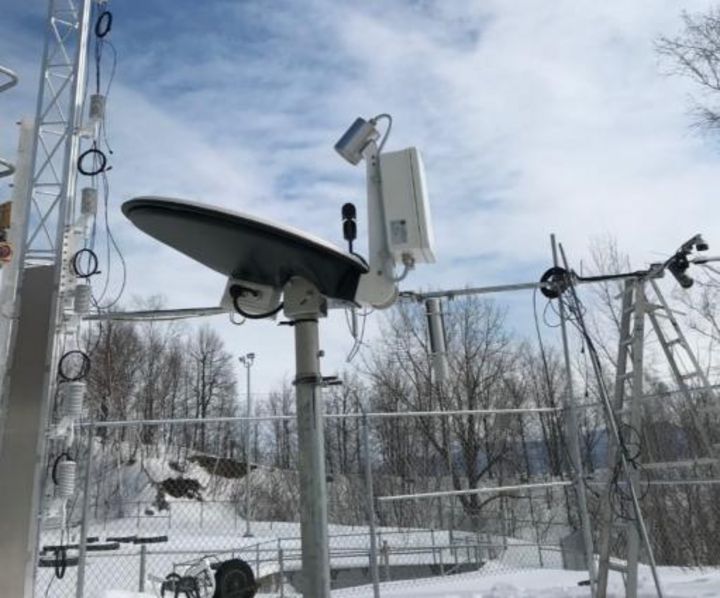
The Earth Observation System (EOS) provides the infrastructure needed to study and document ecosystems in the St. Lawrence River Valley (VFSL) in Quebec in order to develop a quantitative predictive model of system-wide interactions in the geobiosphère-climate of the region. A key aspect of EOS is its ability to include a combination of fixed facilities and a flexible mobile infrastructure to observe and analyze the Dynamic Terrestrial System (DES) in remote areas of Quebec. The VFSL climate is characterized by exceptional weather conditions (eg, ice storms), varied uses of land (urban, natural, etc.) and biodiversity flows (species loss and invasion).
Pilot for the treatment of industrial wastewater containing volatile compounds, for both pedagogy and research and development. It is a flexible equipment that allows feasibility studies on different types of contaminated water. It is composed of :
- 10 l capacity polyethylene feed tank with removable lid
- Total drain valve at the bottom of the tank
- Raw water supply valve
- Variable flow centrifugal feed pump
- Supply pipe at the top of the PVC column
- Control valve and flowmeter on filter supply
- A filtration column on the air stripping bench and modifications on the bench to accept this filtration column
The Aquatic Bio-optics and Biogeochemistry Laboratory enables researchers to study the effects of climate change and permafrost thawing on lake water transparency and mixing dynamics and their multiple impacts on the microbial food chain, greenhouse gas emissions, and oxythermal habitat. Research at the Aquatic Bio-Optics and Biogeochemistry Laboratory also focuses on developing optical equipment for early detection of algal and cyanobacterial blooms and other problems related to water browning.
- Gas chromatography and mass spectrometry
- Ion chromatography
- Atomic absorption spectrometry with flame
- Zetameter
- Infrared spectroscopy
- Total organic carbon analyzer
- High performance liquid chromatography
- UV-Visible spectrophotometer
- Solid phase extraction equipment for hydrocarbons
- Basic analytical equipment
- Oil & grease analyzer
- Activated carbon adsorption column
- Column for aeration tests
- Respirometer
Confocal microscopy and flow cytometry laboratoryThe laboratory is equipped with a four-laser LSRFortessa cytometer that allows high-level multiparametric analyzes to characterize cell populations. A BD FACS Calibur two-laser cytometer is used to perform routine analyzes such as the expression of surface markers. The Zeiss LSM780 confocal microscopy system is a state-of-the-art instrument for the study of various cellular and subcellular biological processes such as intracellular trafficking and localization of pathogen molecules.
The Yargeau Laboratory of Controlling Contaminants of Concern is located at McGill University and is funded by the Canada Foundation for Innovation (CFI) and the Natural Sciences and Engineering Research Council of Canada (NSERC). This state-of-the-art laboratory is the solution to any research need related to the presence, fate, and removal of contaminants in the wastewater treatment process. Equipements include: LC-HRMS ; Microtox; Accelerated solvent extraction system; Microwave extraction system; solide phase extraction.
The Laboratory for Ecotoxicogenomics and Endocrine Disruption (LEPE) brings together the expertise, knowledge, infrastructure and instrumentation necessary to test the effects of contaminants on the health of living organisms. The experiments are carried out in the laboratory, in microcosm, in mesocosm and in the field. The team is developing unique biomarkers for each target species in order to understand and validate the mechanisms of action of contaminants. The group also specializes in the study of endocrine disruptors and has, among other things, ultra-sensitive cell lines that identify contaminants capable of altering the hormonal response.
The researchers at the Environmental Engineering Laboratory are tasked with acquiring knowledge to improve the quality of the environment. In particular, they work in two major areas of research, namely the development of innovative environmental technologies for the rehabilitation of contaminated environments, and the characterization of contaminated environments.
This pilot laboratory is a powerful, mobile and flexible infrastructure for testing and demonstrating, at low cost, and directly in industrial environments or on degraded sites, new remediation and decontamination processes before their implementation on a real scale. . The laboratory team works to develop technologies for the treatment, decontamination and recovery of various matrices polluted by metals and other types of pollutants. The development of processes contributing to sustainable development in the field of environmental technologies is a priority research area of the INRS. The laboratory has a multifunctional mobile pilot plant to operate various types of physical, chemical and biological processes for the treatment of soils, hazardous wastes, gases, as well as industrial residues and effluents directly on contaminated sites.
The main objective of this project is to evaluate different final cover scenarios to reduce the production of leachate in a Saint-Nicéphore landfill, located in Drummondville, Quebec. In order to assess the percolation, the Université de Sherbrooke team proposed to build an experimental plan on the existing coverage of the site. Five lysimeters were built in 4 enclosures, that is to say areas where all the runoff water is collected in order to monitor their quantity and quality over time. The quality must be monitored due to the presence of contaminated soil in some of the scenarios under study, while the quantities are used to carry out water balances over time. This project is done in collaboration with the company Waste Management and receives financial support from WM, CRSNG and CRIBIQ.